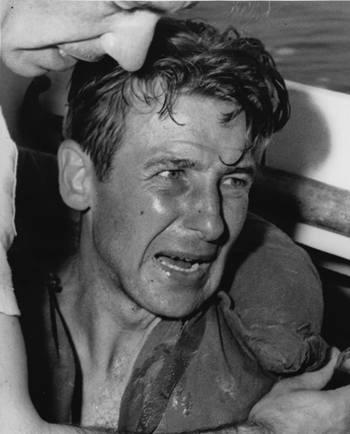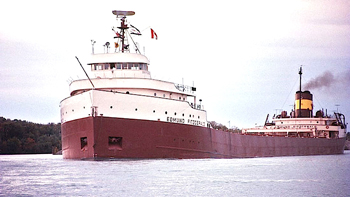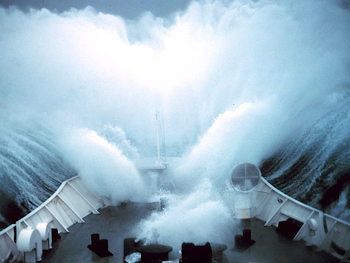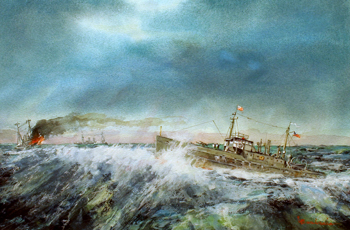Rogue Waves
by Tom Seymour

One of only 20 survivors of the U.S. Coast Guard cutter Jackson. This crewman’s face is contorted with pain from multiple stings by Portuguese man o’wars while awaiting rescue in shark infested waters. Rogue waves sank two 125-foot Coast Guard cutters, Jackson and Bedloe, during the Great Atlantic Hurricane in September of 1944 off the coast of North Carolina. Coast Guard photo.
What are rogue waves and what causes them? Let’s examine the various factors involved in rogue wave formation and the several thoughts and theories regarding their genesis.
Rogue waves are huge waves that can suddenly appear on the open ocean. These, “killer waves,” can disappear as quickly as they appeared, adding to the sense of mystery. Some rogue waves are so massive that even the largest ships are unable to cope with them.
Moreover, while rogue waves are mostly a product of the sea, they can occur on larger freshwater lakes. It is thought that a rogue wave was responsible for the sinking of the Edmund Fitzgerald on Lake Superior. The 729-foot long, 75 foot beam ship, a 25,400 ton cargo of iron ore and its entire crew of 29 were, in an instant, sent to the bottom in 530 feet of water after a rogue wave struck. Launched in 1958, the Fitzgerald was the largest ship on the Great Lakes. Since sinking on November 10, 1975 it remains the largest to have sunk there.
Initial Coast Guard reports blamed the sinking on the crew, maintaining that they did not secure the vessel’s giant hatch covers. Many mariners, though, did not believe the crew would have neglected such an important item in the face of rough weather.
Only recently, divers from The Discovery Channel determined that the Edmund Fitzgerald had met its fate at the hands of a rogue wave, one so huge that it broke the vessel in two, causing it to sink instantly.
Waves Dissected

The 729-foot by 75-foot Edmund Fitzgerald in 1971. The largest ship operating on the American Great Lakes. Recent studies have concluded that the ship was swamped by a rogue wave. It broke in half and instantly went to the bottom with its crew of 29 in 350 feet of water.
Waves have several distinguishing features. The crest is the highest point of a wave and the trough is the lowest point of a wave. Wave height is the distance from the trough to the crest. The distance between wave crests mark a wave’s length. Wave speed, or wave period, is dictated by the amount of time between wave crests and the amount of kinetic energy in a wave is called, “wave energy.”
These characteristics, with the possible exception of wave energy, are all included in government-run marine forecasts and are closely followed by skippers of all vessels. But no matter the forecast, the possibility of rogue waves forming always exists.
For most of recorded history, science knew very little about rogue waves. But newly kindled interest in these killer waves has spurred new research and now, science has a better understanding of this phenomena.
Numerous Factors
A number of variable factors affect wave height. These can include presence of landforms, length of “fetch,” the distance of unobstructed, open ocean that a wave can travel, wind speed and ocean currents. Also, waves interacting with other waves are thought to contribute to rogue waves.
Those on board feared
the ship would break
in two as it teetered
atop the wave crest.
According to an article by Ed Grabianowski on the website, How Stuff Works, ocean currents stand as a major factor in the formation of rogue waves. Ocean currents cause waves to build to great heights when they meet currents in the watery equivalent of a head-on collision.
Major storms create waves up to 50 feet and when one of these waves meets a powerful current, the resulting rogue wave may reach to nearly 100 feet. This was exemplified in the movie, The Perfect Storm. Bob Case, Deputy Meteorologist at the National Weather Service’s Boston, Massachusetts forecast office, described the causes of the so-called, “Perfect Storm “of 1991.
Case said a high-pressure system moving in from northern Canada contained a large pool of cool air. This cold front moved off the New England coast on October 27 and a weak low-pressure system traveled along the front. Cold air behind the front, along with warm air ahead of it, caused sharp temperature contrasts, which, in turn, caused the low-pressure system to quickly strengthen, creating an “extra-tropical cyclone.” With wind blowing from the northeast, the storm qualified as a, “Nor’easter.”
Enter the third ingredient. According to Case, moisture from Hurricane Grace was incorporated into the Nor’easter’s circulation. Thus the ingredients all came together for a ferocious storm with 100 foot waves, the one that sank the fishing vessel, Andrea Gail.
Sudden Appearances

Bow of a ship driving into a rogue wave. Some bows are designed to slice large waves.
What about non-storm-initiated rogue waves? The previously mentioned article by Ed Grabianowski mentions randomly occurring “wave reinforcement.” Wave reinforcement happens this way. When two waves interact, their wave heights are added together. Thus, if a 5-foot wave crosses over a 10-foot wave, a 15-foot wave instantly forms.
Sometimes numbers of waves come together to create a giant wave. This can happen even on relatively calm seas. So if ten 5-foot waves combine, a 50-foot wave can occur. This explains how a rogue wave can appear seemingly out of nowhere. Thankfully, such waves dissipate in only a few minutes.
Wave Science
Until recently, most information on wave heights was from information gleaned from data collected by weather ships. These data suggested that rogue waves probably only occurred every 50 years or so. However, in 2004, the European Space Agency (ESA), began analyzing data from radar-equipped satellites to monitor rogue wave frequency. This was named the “MaxWave Project.”
A third wave, an
estimated 125-footer,
a pyramid with a
huge curl on top,
carried the cutter
to the top of its crest.
In only three weeks, ESA data revealed that 10 waves of 82 feet or more had formed on the world’s oceans. This came as a great surprise, the impact of which spurred scientists to re-evaluate their thoughts on rogue waves. Since then, the ESA has begun another project, called “WaveAtlas.” In this project, scientists will survey seas for a far longer time. This will help to determine a much more accurate estimate regarding the frequency of rogue waves.
Science also uses ocean-based instruments to measure wave heights. A monitoring instrument mounted on an offshore oil rig called the “Draupner Platform, “in the North Sea off the coast of Norway, on January 1, 1995, was measuring waves of from 16–23 feet when in an instant, one wave appeared that measured 66 feet high.
Additionally, Canadian weather buoys around Vancouver measured waves of 100 feet and higher during the decade of the 1990s.
Troopships Hit
During World War II, troopships crossing the Atlantic encountered rogue waves. One of the more notable encounters occurred when a huge rogue wave struck the re-purposed cruise ship, RMS Queen Elizabeth near Greenland in 1942.
The wave shattered windows 90 feet above the waterline, rolling the ship on her side. The vessel was able to recover her balance and thus prevented a historic disaster. RMS Queen Elizabeth had over 10,000 troops on board.
One encounter, noted by the late Albert Jackson of Morrill, Maine, was undoubtedly the work of a rogue wave. Jackson said that looking up when his troopship was at the bottom of the trough, he could see nothing but a giant wall of water. The vessel survived the hit, but according to Jackson, those on board feared the ship would break in two as it teetered atop the wave crest. The creaking and groaning of the stricken ship was almost unbelievable, Jackson said.
Such incidents were not uncommon during the war years, although not all rogue wave encounters received media attention.
Sinking of The Jackson

The Coast Guard cutter Jackson being struck by rogue waves off North Carolina September 14, 1944. The Liberty ship George Ade is in the background burning after a German torpedo strike, being towed by a U.S. Navy tug. Coast Guard image.
The spring, 2019 issue of Proceedings of the Merchant Marine Council United States Coast Guard, contains a story by William H. Thiesen, Ph.D., on the rogue waves that sunk two 125-foot Coast Guard cutters, Jackson and Bedloe, during the Great Atlantic Hurricane of 1944.
The two doomed vessels had received storm warnings while assessing the status of the Liberty Ship, George Ade, along with the navy oceangoing tug that was towing her. The George Ade had suffered a hit from a German torpedo and was on fire.
By the early morning hours of September 14, seas had attained a height of 50 feet, accompanied by winds of 50 mph. Jackson’s crew began securing the vessel against even worse conditions. But in no time, seas had become so high that her radar was unable to locate the other vessels. The George Ade sent out an S.O.S, but Jackson and the other vessels were too occupied with fighting the wind and waves to even take that step.
Soon, wave heights reached 100 feet, negating any effect of the ship’s rudder. So the crew used the vessel’s twin screws for steering. But even that proved too little, since by 10 a.m., winds had reached 100 mph and waves, according to witnesses, were 100 feet high.
Later in the morning even larger waves pummeled Jackson. The vessel was able to recover from the first wave’s assault, but a second wave rolled her to her port side, forcing her mast into the sea. A third wave, an estimated 125-footer, which survivors described as, “a pyramid with a huge curl on top,” carried the cutter to the top of its crest, where fierce winds forced the vessel to her side. She then dove from the wave top to the trough below, where, still on her side, the vessel filled with water and sank into the sea. This happened at 10:30 a.m.
Most of the crew were able to escape. Some, though, had no life preservers and were at the mercy of 125-mph hurricane winds. Others found a semblance of safety in life rafts, but were constantly being ejected by the howling wind and sea. Many were unable to regain their place aboard the rafts and many of those who did died of hypothermia and exposure to the raging elements.
Meanwhile, Bedloe, like Jackson, was capsized and sunk at 1 p.m. It was assumed that Jackson was sunk by waves ahead of the storm’s eyewall, while Bedloe was hit by rogue waves on the backside of the eyewall.
In his article, Thiesen noted the possibility that both Jackson and Bedloe were victims of a series of rogue waves called the, “three sisters.” These behemoths travel the ocean in groups of threes and are large enough to be tracked by radar.
Of the Jackson’s crew, a total of 20 men survived. The Bedloe’s survivors numbered only 12.
The Future
With new interest in rogue waves and increased monitoring of the phenomena, oceangoing vessels should eventually have a better chance of surviving rogue waves due to early warnings of danger. But when waves reach 125-feet high, even the best-prepared vessel has only a slim chance of survival.
Rogue waves remain an ever-present threat, one that our most advanced technology cannot control in the least. Such is the danger to vessels on the high seas.
